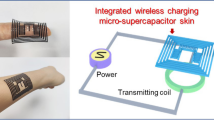Abstract
A novel electrocardiogram (ECG) electrode film is developed by mixing carbon black powder and a quaternary salt with a visco-elastic polymeric adhesive. Unlike traditional wet gel-based electrodes, carbon/salt/adhesive (CSA) electrodes should theoretically have an infinite shelf life as they do not dehydrate even after a prolonged period of storage. The CSA electrodes are electrically activated for use through the process of electrophoresis. Specifically, the activation procedure involves sending a high voltage and current through the electrode, which results in significant reduction of impedance so that high fidelity ECG signals can be obtained. Using the activation procedure, the ideal concentration of carbon black powder in the mixture with the adhesive was examined. It was determined that the optimum concentration of carbon black which minimized post-activation impedance was 10%. Once the optimal carbon black powder concentration was determined, extensive signal analysis was performed to compare the performance of the CSA electrodes to the standard silver–silver chloride (Ag/AgCl) electrodes. As a part of data analysis, electrode–skin contact impedance of the CSA was measured and compared to the standard Ag/AgCl electrodes; we found consistently lower impedance for CSA electrodes. For quantitative data analysis, we simultaneously collected ECG data with CSA and Ag/AgCl electrodes from 17 healthy subjects. Heart rate variability (HRV) indices and ECG morphological waveforms were calculated to compare CSA and Ag/AgCl electrodes. Non-significant differences for most of the HRV indices between CSA and Ag/AgCl electrodes were found. Of the morphological waveform metrics consisting of R-wave peak amplitude, ST-segment elevation and QT interval, only the first index was found to be significantly different between the two media. The response of CSA electrodes to motion artifacts was also tested, and we found in general no difference in the quality of the ECG signal between the two media. Hence, given that CSA electrodes are expected to have a very long shelf-life, with potentially less cost associated with their fabrication, and have ECG signal dynamics nearly identical to those of Ag/AgCl, the new electrodes provide an attractive alternative for ECG measurements.






Similar content being viewed by others
References
Akselrod, S., D. Gordon, F. A. Ubel, D. C. Shannon, A. C. Berger, and R. J. Cohen. Power spectrum analysis of heart rate fluctuation: a quantitative probe of beat-to-beat cardiovascular control. Science 213:220–222, 1981.
Appel, M. L., R. D. Berger, J. P. Saul, J. M. Smith, and R. J. Cohen. Beat to beat variability in cardiovascular variables: noise or music? J. Am. Coll. Cardiol. 14:1139–1148, 1989.
Baek, J.-Y., J.-H. An, J.-M. Choi, K.-S. Park, and S.-H. Lee. Flexible polymeric dry electrodes for the long-term monitoring of ECG. Sens. Actuators Phys. 143:423–429, 2008.
Benedek, I. Pressure-Sensitive Formulation. Utrecht: VSP, 2000.
Benedek, I. Pressure-Sensitive Adhesives and Applications. Boca Raton: CRC Press, 2004.
Delano, M. K., and C. G. Sodini. A long-term wearable electrocardiogram measurement system, 2013. doi:10.1109/BSN.2013.6575459.
Gruetzmann, A., S. Hansen, and J. Müller. Novel dry electrodes for ECG monitoring. Physiol. Meas. 28:1375–1390, 2007.
Heart rate variability. Standards of measurement, physiological interpretation, and clinical use. Task Force of the European Society of Cardiology and the North American Society of Pacing and Electrophysiology. Eur. Heart J. 17:354–381, 1996.
Jung, H.-C., J.-H. Moon, D.-H. Baek, J.-H. Lee, Y.-Y. Choi, J.-S. Hong, and S.-H. Lee. CNT/PDMS composite flexible dry electrodes for long-term ECG monitoring. IEEE Trans. Biomed. Eng. 59:1472–1479, 2012.
Lerner, K. L., and B. W. Lerner. The Gale Encyclopedia of Science. Detroit: Cengage Gale, 2008.
Pomeranz, B., R. J. Macaulay, M. A. Caudill, I. Kutz, D. Adam, D. Gordon, K. M. Kilborn, A. C. Barger, D. C. Shannon, and R. J. Cohen. Assessment of autonomic function in humans by heart rate spectral analysis. Am. J. Physiol. 248:H151–H153, 1985.
Reyes, B. A., H. F. Posada-Quintero, J. R. Bales, A. L. Clement, G. D. Pins, A. Swiston, J. Riistama, J. P. Florian, B. Shykoff, M. Qin, and K. H. Chon. Novel electrodes for underwater ECG monitoring. IEEE Trans. Biomed. Eng. 61:1863–1876, 2014.
Ruffini, G., S. Dunne, L. Fuentemilla, C. Grau, E. Farrés, J. Marco-Pallarés, P. C. P. Watts, and S. R. P. Silva. First human trials of a dry electrophysiology sensor using a carbon nanotube array interface. Sens. Actuators Phys. 144:275–279, 2008.
Searle, A., and L. Kirkup. A direct comparison of wet, dry and insulating bioelectric recording electrodes. Physiol. Meas. 21:271–283, 2000.
Vidaurre, C., T. H. Sander, and A. Schlögl. BioSig: the free and open source software library for biomedical signal processing. Comput. Intell. Neurosci. 2011:935364, 2011.
Wang, L.-F., J.-Q. Liu, B. Yang, and C.-S. Yang. PDMS-based low cost flexible dry electrode for long-term EEG measurement. IEEE Sens. J. 12:2898–2904, 2012.
Webster, J. Medical Instrumentation: Application and Design, 3rd ed. Wiley India Pvt. Limited, 2009.
Conflict of interest
FLEXcon supported the present study and might be interested in commercializing CSA electrodes in the future. FLEXcon employees (KB and JP) may have conflict of interest as they are employed by the company.
Author information
Authors and Affiliations
Corresponding author
Additional information
Associate Editor Tingrui Pan oversaw the review of this article.
Rights and permissions
About this article
Cite this article
Posada-Quintero, H.F., Reyes, B.A., Burnham, K. et al. Low Impedance Carbon Adhesive Electrodes with Long Shelf Life. Ann Biomed Eng 43, 2374–2382 (2015). https://doi.org/10.1007/s10439-015-1282-y
Received:
Accepted:
Published:
Issue Date:
DOI: https://doi.org/10.1007/s10439-015-1282-y




